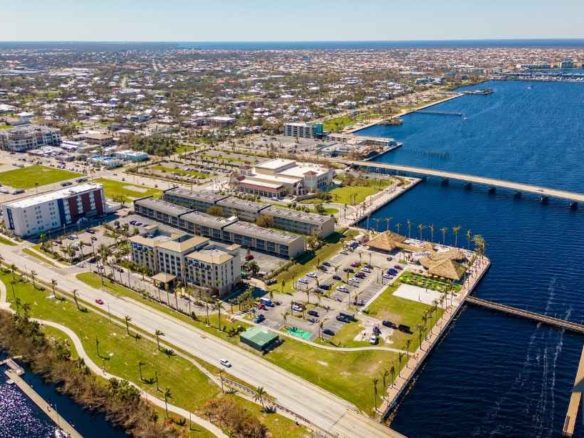Carolina is a nice place to live. It offers stunning landscapes, a welcoming society, and a thriving economy. North Carolina offers something for everyone, from Wilmington’s relaxed atmosphere to Charlotte’s vibrant metropolitan life.
It offers a lively mix of urban and coastal living, making it an appealing place for many. Known for its proximity to San Juan, the area has a rich culture, great food, and beautiful beaches, particularly in Isla Verde. Residents appreciate its warm climate, access to nature, and vibrant community, with many amenities close by. However, like much of Puerto Rico, it faces challenges such as economic fluctuations and the impact of tropical storms. Still, with friendly locals, a strong sense of community, and a laid-back lifestyle, Carolina can be a great option for those seeking a blend of city conveniences and island charm.

Culture
The Carolinas’ culture is a unique component of the broader Southern culture. Notably, Europeans arrived in the coastal Carolinas more than a century before they did in the South’s interior. Many of the first governors during the United Period were from Barbados, an English colony that had a significant early influence on Caribbean culture.
Despite being part of the Southern United States, North and South Carolina have historically differed in a number of ways, including in terms of economic growth, political development, and settlement patterns.
Economy
Similar to other [Southern] states, North Carolina remained mostly a region of small farms and industry until the conclusion of World War II, relying on tenancy and sharecropping, particularly for black laborers, and a small number of labor-intensive crops. The Carolinas stand out due to their numerous small-scale textile, furniture, and tobacco enterprises, as well as their economic reliance on tobacco, cotton, and rice.
The Carolinas, especially North Carolina, had a stronger industrial base thanks to these sectors than the majority of Southern states. Many rural and small urban communities suffered economically as farming became more mechanized, textile, garment, and furniture jobs were shifted due to globalization, and the tobacco sector declined. Both states started to see expansion in the banking and technology sectors in the late 20th century, which brought new economic industries, jobs, and population increases. Similar to previous industrialization, these shifts were more noticeable in North Carolina, whereas South Carolina’s economic growth slowed for a number of years.
Charlotte becoming the second-largest financial district in the US after New York City, North Carolina has been a financial center since the 1980s. In addition to six other Fortune 500 companies, including Lowe’s, Duke Energy, Nucor, Honeywell, Brighthouse Financial, and Sonic Automotive, Charlotte is home to the headquarters of several significant publicly traded corporations, including Bank of America, Truist Financial, Wells Fargo’s East Coast operations, and Centene Corporation.
Crime rate in Carolina
The crime rate is one of the most important things to take into account when deciding where to relocate. Although there are a lot of safe cities in North Carolina, many urban regions are notoriously violent.
Raleigh has a greater rate of property crime than the national average but a lower rate of violent crime. Overall, both violent and property crime decreased by 1.4% in North Carolina. NC has fewer violent crimes but more property crimes than South Carolina.
Whiteville, Henderson, and Wadesboro have the highest rates of crime. Moving to practically any part of North Carolina is safe.
People Who Live in Cary
The residents of Cary, North Carolina, are among the best; your neighbors are important! Some of the most expensive real estate in the Triangle region of North Carolina may be found in Cary and Chapel Hill.

Cary is in a great location close to desirable attractions, including top-notch schools, Research Triangle Park, Downtown Raleigh, Durham, and the Raleigh Durham International Airport. Over the past 25 years, Cary’s population has increased rapidly, from 45,000 to over 180,388 residents. As a result, people are flocking there. People are coming from all over the world to Cary, North Carolina, and most of them didn’t grow up here.
Education: Schools in Cary, NC
The cornerstone of a successful family community like Cary’s is education. The schools are among the best in the country, which is a great motivation to apply. In addition, there are a number of private schools in the region, including Chesterbrook Academy and Cary Academy.
There aren’t many better schools in Cary if you’re looking for a top-notch education. Some of the best schools in the area include Panther Creek High School, Green Level, and Green Hope; thus, many homebuyers will look just in these school districts.
Employment in the Cary Region
According to Glassdoor, the Raleigh-Cary region is currently the top job location in the US. Job transfers are the main reason for the large number of individuals moving to the area. MetLife recently established its technological headquarters in Cary, and RTP is located next door. Cary’s proximity to the airport simplifies traveling to other states
Businesses like Google, SAS, IBM, Cisco, Apple, and others are relocating to the region, focusing on technology, healthcare, and education. The fact that North Carolina offers these businesses additional tax incentives is one of the allures.
Raising a Family in Cary
Raising a family is one of the primary motivations for people to relocate to Cary, North Carolina. Forbes named the Raleigh region as the greatest place to raise a family. This is consistent with all of the ideals that the town of Carroll upholds. It maintains the atmosphere of a small-town neighborhood while being big enough to be a city.
You should be aware of the greatest neighborhoods in the Cary, North Carolina, area if you are raising a family there. Another excellent area in which to raise a family is Apex, which is Cary’s neighbor. Both cities consistently rank among the top 10 locations to live in the nation and offer excellent educational systems and reasonably priced housing.
Weather in Cary
When deciding where to reside, the climate is a major consideration. Southerners love the change of seasons, but Northerners typically relocate to North Carolina to avoid the harsh winters. Winters are usually pleasant here in the Triangle, and the warmer weather lasts longer.
Some of the greatest parks and outdoor recreation areas are accessible throughout the autumn. Bond Park offers breathtaking views of the lake, and the trails are more pleasant to run or walk on as the leaves change color.
It usually doesn’t stay cold enough for snow to remain in Cary for very long, so if it does, it’s likely to be gone in a day. The mountains are very close, which is good news for those who enjoy snow activities. You will understand exactly what we mean if you take a trip to Asheville and the Appalachian Mountains.
The Cost of Living in Cary
A lot of folks who are relocating to Cary are curious about the cost of living. Cary is an excellent value in relation to the average salary because it is lower than the national average in many categories. The percentage of those making over $100,000 was highest in the Raleigh area.
Pros and Cons of Cary, NC Living
Pros
- Fantastic community
- Fantastic location
- Cost-effectiveness
- A thriving labor market
- Excellent safety rating
- Outstanding instruction
- Excellent entertainment
- Delicious food
- A welcoming environment for families
- Many festivals
- Many parks and green areas
Cons
- Absence of nightlife
- Regular building as the region expands
- High relative humidity
- High levels of pollen during the spring
Faqs
Biggest risks of living in North Carolina?
In North Carolina, severe thunderstorms, hurricanes, tornadoes, and floods are frequent occurrences. Land locations are at risk from tornadoes and flash floods, whereas coastal areas are especially at risk from storms. If you are keen to purchase a beach house, keep this in mind.
Why is North Carolina cheap to live in?
North Carolina’s cost of living is neither very low nor high. It is, however, roughly 4% less expensive than the typical American metropolis. Eleven states have a flat income tax rate, including North Carolina. It also indicates that the tax rate is the same for each person.
What is the crime rate in North Carolina?
North Carolina has a crime rate of 24.9 per 1,000 people, which includes both property and violent offenses. The City of North Carolina has an average crime rate of 23 offenses per square mile. North Carolina’s rates of property crime and violent crime are both higher than the median crime rates for the entire US.







Join The Discussion